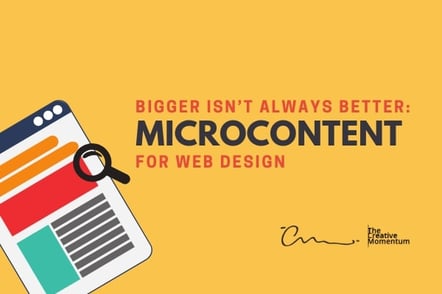
Microcontent is a type of UX optimization that taps into the power of brevity, minimalism, and our limited attention spans to drive engagement. It’s certainly not a new tool in the marketer’s kit, and in fact, every website is already using it. The question is, do the creators of these websites understand the power of microcontent for web design? Or is it falling by the wayside in favor of bigger marketing goals?
Let’s review microcontent in more depth.
What is Microcontent?
Much as it sounds, microcontent is any type of short-form content that can be quickly consumed.
- Short video clips
- Animations
- Images
- Headlines
- Social media posts
- Metadata/HTML tags
- Short text blocks
More specifically, microcontent is any content element on your page designed to provide information in short snippets or fragments. They’re usually meant to stand alone, without any supporting text or contextual details given.
For example, the email subject lines you create for your drip campaigns are considered a type of microcontent—but the 300-word email copy itself is not.
Typically, microcontent is presented in the context of larger messaging, usually taking the form of a key value proposition or focal point for readers to hone in on. It’s easy to see how headlines and subject lines fall into this category, but the concept applies just as much to your visuals, web copy, and SEO tags.
Of course, it’s a bit trickier to wrap your head around than it appears. The process of labeling raises questions; for example, does every headline qualify as microcontent? What makes microcontent different than any number of short-form blogs scattered around the web? And how can a company tap into microcontent to improve its web design?
Let’s dive deeper into how microcontent can be used to boost your web design goals.
It’s a Way of Thinking About UX Copywriting
Microcontent isn’t a new type of content, per se. You’re already using it in your headlines, social media marketing, and email marketing. And that’s the point. This isn’t a new strategy, but rather a more productive way of thinking about your existing web design elements.
The primary benefit of microcontent in general is that it supports a simple UX by keeping messages short, focused, and to the point. Social media posts are a great example of this type of distilled messaging, particularly on sites like Twitter where character count is limited. This “micro” framework forces marketers to keep their messages brief, which audiences tend to appreciate.
And as we’ll discuss, this mindset can yield benefits for nearly every aspect of your site design. Let’s look at a few examples.
Headline Optimization
Readers form impressions of a piece of content in an instant, whether that content is an article, your website, or your email blasts. For example, they’ll decide whether they like the visual aesthetic of your website within one second of viewing—and the same judgements apply to your content. If readers can’t immediately ascertain what they’re supposed to be focusing on, they’ll get bored and move on.
It’s this lack of attention span that makes microcontent so powerful. When readers scan for information, they filter out unfocused messaging and focus in on key points of value. And the more valuable a piece of content appears at a glance, the more likely it is that it’ll pique their interest.
To distill all that into a microcontent-friendly soundbite: good headlines get clicks.
Metadata and SEO
Page metadata is possibly the best example of microcontent in action. By their nature, HTML tags, meta descriptions, and other SEO markers are structured bits of microcontent that search crawlers use to learn about a page. In the past, a page’s tags and meta descriptions were the only context that a search crawler had to learn about the page. And depending on how well the SEO strategy was deployed, the content would rank higher in search.
Think of this as a microcosm for how microcontent works on a larger scale. Taking a focused approach to each piece of content you create—whether it’s a headline, title tag, or image—helps users understand the page at a glance. It’s the same fundamental concept that highlights the importance of taking a focused approach to content creation, whether you’re designing for humans or for SEO.
Content Summaries
Microcontent doesn’t require context, but it can provide context. This is most apparent when looking at your content library and the summaries you’re using to sell each article. Each article summary should provide just enough information to pique the reader’s interest, usually by dangling one or two of the article’s key value propositions. This is the perfect example of microcontent’s role in supporting your bigger content assets.
For example, if your new article isn’t driving clicks, you can take a look at how the article’s microcontent is presenting the piece. Is the headline focused and direct? Is the summary enticing without giving away the lesson? Microcontent is an essential marketing element for this type of content, and better yet, it’s far easier to adjust it than it is to write new content from scratch.
You’re Already Using Microcontent—But Are You Using it Well?
Microcontent isn’t a new strategy. It’s a new perspective. Every aspect of your web design, from your visuals to your web copy to the text included in your visual hierarchy will influence how users perceive your brand. And too often, these smaller site optimizations are considered less essential when compared to bigger decisions about site layout, navigation, and branding. But bigger isn’t always better, and you shouldn’t underestimate the marketing potential of your microcontent.

